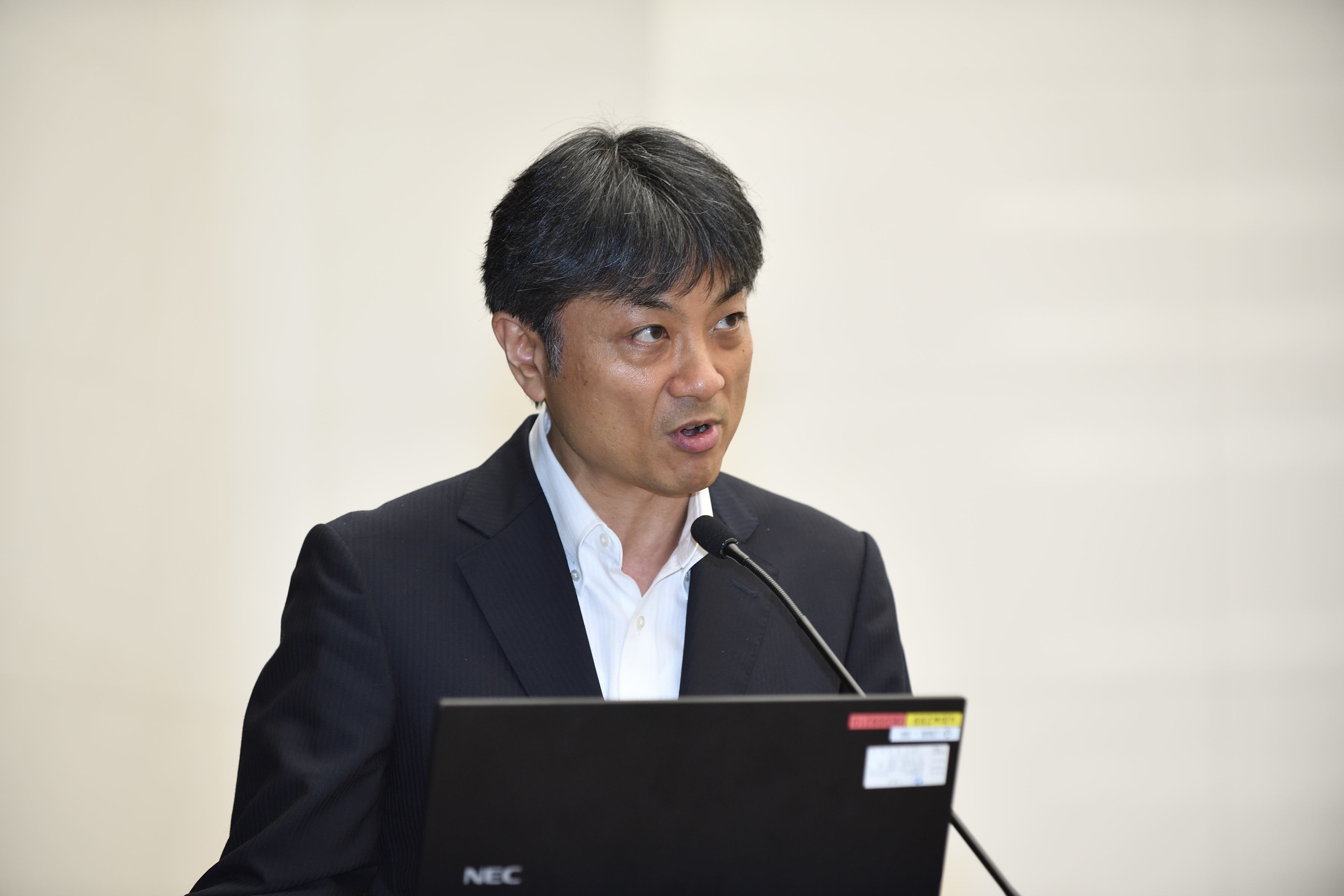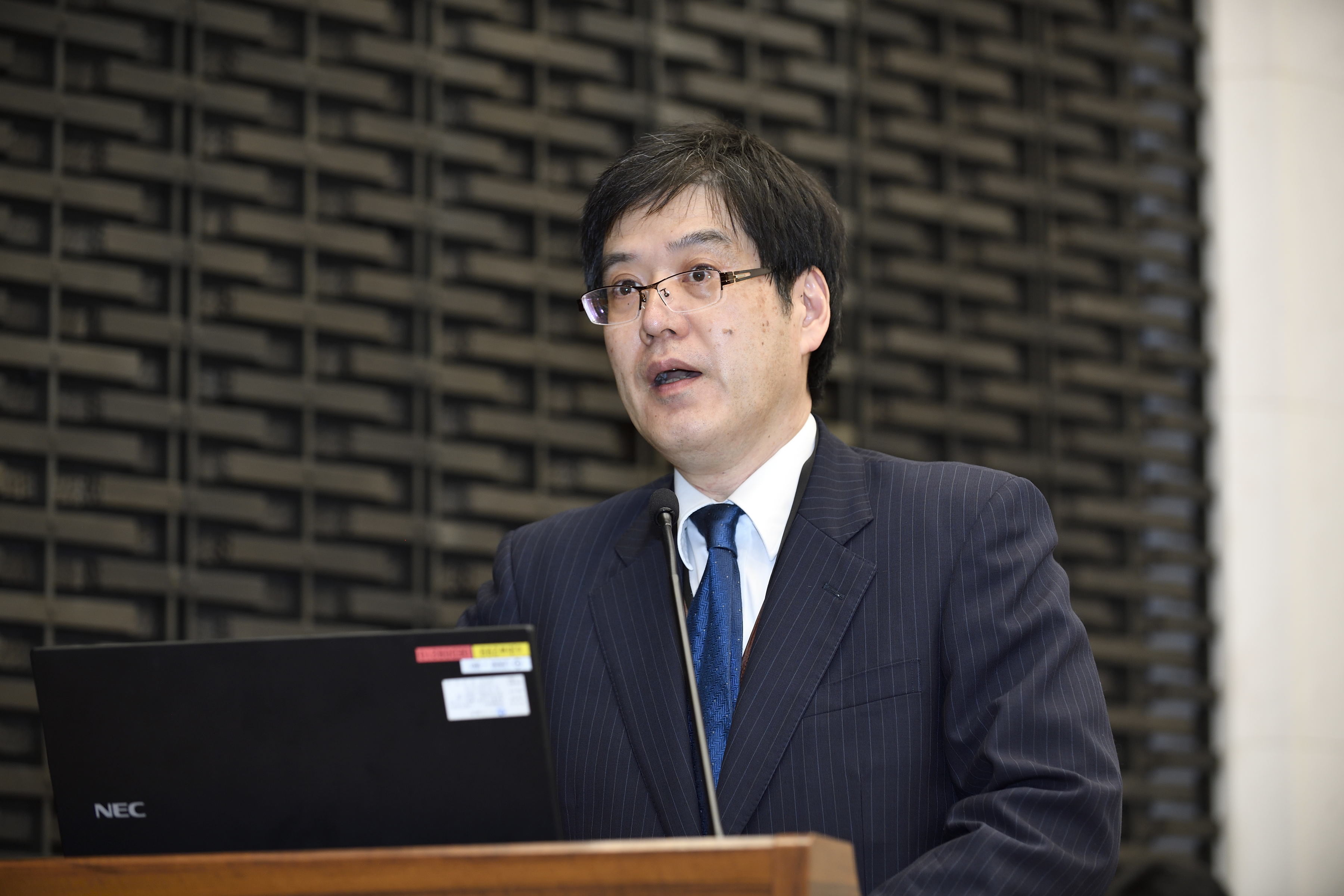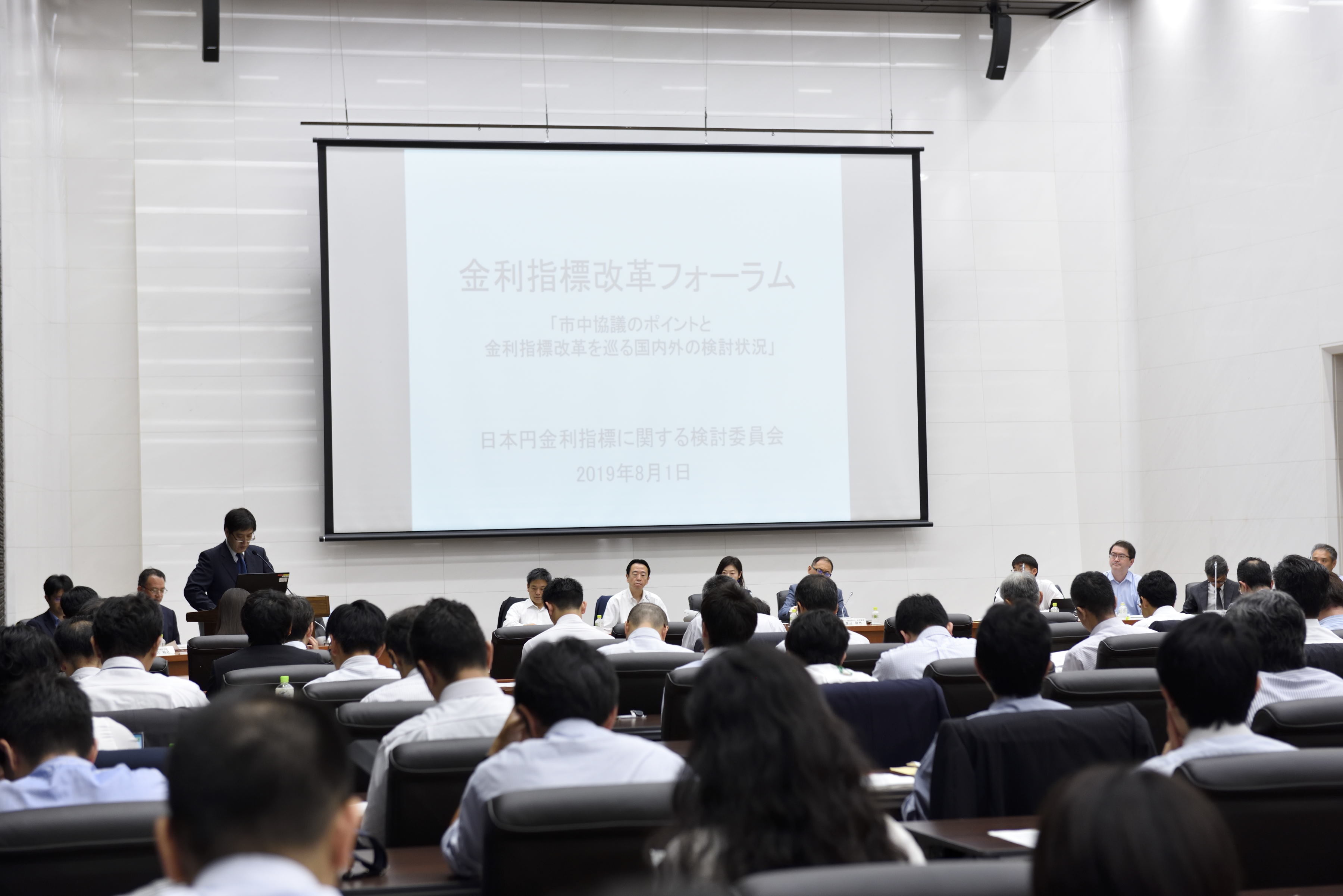Interest Rate Benchmark Reform Forum "Main Points of the Public Consultation and Overview of Deliberations on Interest Rate Benchmark Reform in Japan and Abroad"
August 30, 2019
On August 1, 2019, the Cross-Industry Committee on Japanese Yen Interest Rate Benchmarks (hereinafter the "Committee") held a forum "Main Points of the Public Consultation and Overview of Deliberations on Interest Rate Benchmark Reform in Japan and Abroad."
The possibility that LIBOR will be permanently discontinued after the end of 2021 has been increasing. This is likely to affect business operations of a wide range of relevant parties such as financial institutions, non-financial corporates, and institutional investors, given that LIBOR is used as an interest rate benchmark for a variety of financial transactions, including loans, bonds, and derivatives. Therefore, relevant parties are required to be prepared for the discontinuation of LIBOR.
Meanwhile, on July 2, 2019, the Committee released the "Public Consultation on the Appropriate Choice and Usage of Japanese Yen Interest Rate Benchmarks," which was intended to outline the outcome of past discussions on interest rate benchmark reform and solicit comments regarding the future structure of Japanese yen interest rate benchmarks from a wide range of relevant parties.
In this forum, presenters gave an overview of deliberations on interest rate benchmark reform in Japan and abroad, focusing on the main points of the public consultation, initiatives related to derivatives, and the international progress on interest rate benchmark reform.
Opening Remarks, Presentations, etc.
Opening Remark by Seiichi Shimizu, Director-General of the Financial Markets Department, Bank of Japan
The need to accelerate interest rate benchmark reform
Progressive efforts toward interest rate benchmark reform have been made in each jurisdiction. In Japan, comprehensive discussions toward interest rate benchmark reform have been held in line with the progress in other jurisdictions. That said, there are only two and a half years to go until the potential permanent discontinuation of LIBOR, and enormous and varied challenges remain for the transition from LIBOR. Thus, relevant parties including non-financial corporates and industry groups are requested to accelerate efforts toward reform by proceeding with practical arrangements and identifying issues for consideration. If relevant parties could take advantage of the opportunity to submit comments on practical issues to the public consultation, this will likely make their internal discussions on interest rate benchmark reform more productive.
Market initiatives toward creating a market for the risk free rate
On July 30, 2019, it was announced that the "Task Force on Term Reference Rates" will be established to provide practical support to the calculating and publishing entities of Term Reference Rates. Cooperation and support from all market participants and end-users are essential to realizing the calculation and publication of robust Term Reference Rates and making them a credible benchmark to be actually used in contracts. Therefore, it is important that the initiatives toward creating a market for Term Reference Rates be advanced together by all relevant parties.
Opening Remark by Tokio Morita, Director-General of the Strategy Development and Management Bureau, Financial Services Agency
Necessity of actions to prepare for the LIBOR discontinuation
I would like to emphasize that London Interbank Offered Rate (LIBOR), which has been an important financial infrastructure, is expected to be discontinued, and that market participants should take necessary actions in consideration of the deadline at the end of 2021.
Actions to manage the transition away from LIBOR
To mitigate the impact of the LIBOR discontinuation, it would be appropriate to consider (1) using non-LIBOR interest rate benchmarks for new contracts as much as possible, and (2) including a "fallback" clauses to existing contracts with maturities exceeding the end of 2021.
(3) If it is inevitable to use LIBOR for reference to new contracts whose maturity exceeds the end of 2021, such contracts should also accompany at least fallback clauses. Still, it should be kept in mind that the risk of continuous reference for LIBOR in the new contracts would not only be exposed to your firm but also affect customers and a wide range of market participants, depending on the type of financial transaction.
Role of the JFSA
In order to make an orderly transition away from LIBOR, we will support the market-wide initiatives to carry out the transition plan shown in the public consultation.
Regarding Tokyo Interbank Offered Rate (TIBOR), we continue to support efforts taken by the JBA TIBOR administrator (JBATA) to improve the appropriateness of TIBOR calculation and its robustness.
In addition, we will monitor actions taken by financial institutions, starting from the review of their transition plans, and encourage them to provide their customers with appropriate financial services in a timely manner.
Presentations and List of the Participants
Deliberations in the Committee and main points of the public consultation on Japanese yen interest rate benchmarks
[Presenter]
Taro Matsuura, Managing Director, Head of Corporate Planning Division, MUFG Bank, Ltd. (Chair, Committee)
Initiatives for the calculation and publication of Term Reference Rates based on the risk-free reference rate
[Presenter]
(Committee Secretariat)
[Material]
Establishment of the "Task Force on Term Reference Rates" [PDF 161KB]
ISDA's initiatives
[Presenter]
Tomoko Morita, Senior Director and Head of Tokyo Office, ISDA
[Main points]
- Overview of the final results of the consultation published last year on technical issues related to new fallbacks for derivatives referencing GBP LIBOR, CHF LIBOR, JPY LIBOR, and BBSW.
- Overview of the supplemental consultation on adjustments for fallbacks in derivatives referencing certain other IBORs such as USD LIBOR as well as that on pre-cessation issues, both launched in May.
- Selection of a fallback adjustment vendor (July 2019).
- Future work plan:
Aug. 2019: Publication of the consultation on the parameters and mechanics of the term and spread adjustments for fallbacks
Dec. 2019: Publication of ISDA's amended definitions
Mar. 2020: Effective date for the amendments to the ISDA definitions
Overseas developments and international initiatives
[Presenter]
Atsuya Watanabe, Director, Administration, Markets and Securities Services, Citigroup Global Markets Japan Inc.
[Main points]
- Case studies of newly issued bonds referencing SOFR and SONIA in which findings indicated that calculation methodology for daily compounding of these RFRs (fixing in arrears) has not yet necessarily been standardized.
- Overview of the fallback language for loans being deliberated in USD based on the results of the ARRC's consultation on syndicated loans and bilateral business loans.
- Overview of the potential conventions for interdealer trading of RFR-RFR and RFR-IBOR cross currency swaps based on the ARRC's preliminary report on potential interdealer cross-currency swap market conventions.
FAQs
Regarding the questions asked by the participants in advance, the Committee provided explanations as below.
Regarding accounting issues, in a case, for example, where interest rate benchmarks of a hedged item and a hedging instrument do not exactly match, this could have a significant impact on accounting profit. Given that it is important for the Accounting Standards Board of Japan (ASBJ) to determine rules at an early stage, what is the schedule for establishing these rules?
While accounting issues have been deliberated by the ASBJ, there are still many undecided factors that need resolving, and the Committee understands that a specific deliberation schedule has yet to be established.
Meanwhile, these issues, which are international challenges, have been deliberated across currencies by the International Accounting Standards Board (IASB). This is divided into two phases: Phase 1 that focuses on pre-replacement issues and Phase 2 that focuses on replacement issues. The IASB conducted a public consultation on relief measures in Phase 1 and will reach a conclusion by the end of the year. While the deliberation schedule for Phase 2 has not been disclosed, it has been heard that, among comments gathered through the public consultation in Phase 1, a majority asked for potential circumstances related to hedge accounting after the replacement to be identified at an early stage.
The Committee understands that the ASBJ is deliberating on this matter while keeping consistency with the progress of deliberations overseas.
While the determination process of alternative benchmarks, the decision makers, and the methods for publication did not seem to be mentioned in the public consultation, will the Committee decide on these points going forward? Otherwise, will market conventions be gradually formed among market participants without explicit determination by the Committee?
It will be difficult for the Committee to choose a specific option for alternative benchmarks because each option has different features and it is expected that contracting parties will choose appropriate alternative benchmarks in accordance with the characteristics of financial instruments and transactions.
Meanwhile, as the results of the public consultation show which alternative benchmark has gained majority support on a product-by-product basis, and this encourages market participants to understand and use alternative benchmarks, it is expected that the options for alternative benchmarks will be converged. Moreover, it is likely that alternative benchmarks will consequently have higher liquidity and a greater price-discovery function.
With regard to external communication, I would like the Committee to promptly ensure that all relevant parties, whether financial institutions or non-financial corporates, are aware of preparations for the potential permanent discontinuation of LIBOR. Moreover, I would like the Committee to explicitly indicate the deadlines for necessary actions, such as modifying contracts and addressing accounting issues, and share developments in deliberations on benchmark reforms in the United States and Europe.
Since LIBOR is used differently depending on the industry and size of each company, it is difficult to provide a uniform basis for preparations for the permanent discontinuation of LIBOR and specific timelines. Thus, it is necessary, first and foremost, that each company comprehensively identifies issues to address at a company level using Chapter 4 of the consultation document as reference.
Regarding challenges faced by each company upon addressing these issues, it will be necessary to find solutions with support from experts such as attorneys and industry groups, depending on the shape of the challenge. In addition, as for issues that need to be addressed on a market-wide basis, the Committee hopes that each company shares them widely with market participants and other relevant parties through the public consultation.
The Committee has posted on its website information on developments in national and international discussions concerning interest rate benchmarks. Specifically, the Committee has summarized and posted the status of discussions in the United Kingdom, the euro area, Switzerland, and the United States, as well as international initiatives by the FSB, IOSCO, ISDA, and others, focusing on developments since 2017.
The Committee will continue to work to provide similar information, while sufficiently considering which information is necessary, update intervals, and the depth of information, based on feedback obtained.
Pictures

Seiichi Shimizu, Director-General of the Financial Markets Department, Bank of Japan

Tokio Morita, Director-General of the Strategy Development and Management Bureau, Financial Services Agency

One Scene from the Forum
(Photo: Shoichi Nose)
